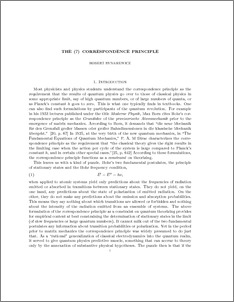Rynasiewicz, Robert
(2013)
The(?) Correspondence Principle.
[Preprint]
![[img]](https://philsci-archive.pitt.edu/style/images/fileicons/application_pdf.png)  Preview |
|
PDF (to appear in One Hundred Years of the Bohr Atom: A Centennial Conference on Niels Bohr, edited by Finn Aaserud and Helge Kragh)
TheCorrespondencePrinciple.pdf
- Draft Version
Download (167kB)
|
Abstract
One finds, even in texts by distinguished physicists, diverse enunciations of the correspondence principle. Typical is that quantum mechanics should agree with classical mechanics in some appropriate limit. Most commonly, the limit specified is that of high quantum numbers, or of large masses and orbits of large dimensions. But sometimes it is specified as mean behavior when large numbers quanta are involved, or sometimes even as just the average of quantum mechanical variables. Sometimes, the principle is even taken as a prescription for replacing the classical dynamical observables with an appropriate mathematical operator. In 1918, however, Bohr proposed what he would later call the correspondence principle as a way of deriving amplitudes and polarizations of emitted and absorbed spectral lines. I will begin with Bohr's principle and trace the evolution of correspondence considerations through the 1920's, with a view as to whether in each case it is supposed to play the role of a theorem, an adequacy constraint, an inductive hypothesis or a heuristic.
Monthly Views for the past 3 years
Monthly Downloads for the past 3 years
Plum Analytics
Actions (login required)
 |
View Item |



